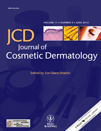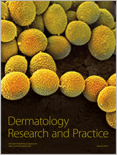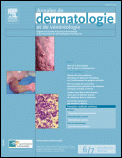
Journal of Cosmetic Dermatology
Scope & Guideline
Bridging Science and Practice in Cosmetic Dermatology
Introduction
Aims and Scopes
- Cosmetic Dermatology Treatments and Innovations:
The journal covers a wide range of topics related to cosmetic dermatology, including new techniques, devices, and formulations aimed at enhancing aesthetic outcomes and patient satisfaction. - Safety and Efficacy Assessments:
Research on the safety and effectiveness of various cosmetic treatments, including injectable fillers, laser therapies, and topical agents, is a core focus, ensuring that practitioners have access to validated data. - Patient-Centric Research:
The journal emphasizes studies that assess patient experiences, satisfaction, and psychosocial impacts of cosmetic procedures, recognizing the importance of the patient's perspective in cosmetic dermatology. - Emerging Technologies and Trends:
Exploration of new technologies, such as artificial intelligence and advanced imaging techniques, which are shaping the future of cosmetic dermatology practice. - Interdisciplinary Approaches:
Encouraging collaborations across disciplines, the journal promotes research that integrates dermatology with other medical fields, such as psychology, nutrition, and pharmacology, to enhance treatment outcomes.
Trending and Emerging
- Integrative and Holistic Approaches:
There is a growing emphasis on integrative treatments that consider the whole patient, including their psychological and emotional well-being, in addition to physical aesthetic outcomes. - Artificial Intelligence and Technology Integration:
The incorporation of artificial intelligence and technology in diagnostics and treatment planning is trending, reflecting the industry's shift towards precision medicine. - Regenerative and Stem Cell Therapies:
Research into regenerative treatments, particularly those utilizing stem cells and growth factors, is on the rise, indicating a shift towards more natural and effective healing methods. - Personalized Medicine in Dermatology:
A trend towards personalized cosmetic treatments based on genetic, environmental, and lifestyle factors is emerging, allowing for tailored therapies that improve efficacy and patient satisfaction. - Post-Pandemic Cosmetic Trends:
Studies addressing changes in cosmetic procedures and patient expectations resulting from the COVID-19 pandemic, including increased interest in teledermatology and home care products, are gaining traction.
Declining or Waning
- Traditional Surgical Techniques:
There has been a noticeable decrease in studies focusing on traditional surgical techniques in cosmetic dermatology, as newer, less invasive methods gain popularity. - Generalized Cosmetic Procedures:
Research that broadly addresses cosmetic procedures without specifying techniques or patient demographics is declining, as the field shifts towards more targeted and personalized approaches. - Aging and Anti-Aging Formulations:
While still relevant, the volume of studies specifically dedicated to anti-aging formulations has waned, potentially due to saturation in the market and growing interest in holistic and preventive dermatology. - Static Cosmetic Procedures:
An observable decline in studies focusing solely on static cosmetic procedures, such as basic filler applications, is evident as practitioners seek to enhance dynamic and holistic treatment approaches. - Cosmetic Education and Training:
Research and discussions surrounding cosmetic education and training methodologies are less frequent, which may reflect a shift towards practical, hands-on training in clinical settings rather than theoretical discussions.
Similar Journals

Cosmetics
Innovating Cosmetic Solutions for a Radiant FutureCosmetics is a prominent open-access journal published by MDPI in Switzerland, dedicated to advancing research in the fields of dermatology, pharmaceutical science, and chemical engineering, among others. Launched in 2014, this interdisciplinary journal seeks to provide a platform for the dissemination of innovative studies surrounding topical formulations, cosmetic development, and skin health, contributing to a deeper understanding of aging processes and their implications in cosmetic science. With an impressive array of quartile rankings, including Q2 placements in key categories such as Chemical Engineering and Dermatology, as well as a strong Scopus ranking showing its relevance and impact within the community, Cosmetics serves as a vital resource for researchers, professionals, and students alike. Access to its rich content is readily available through its open-access model, ensuring that breakthroughs in cosmetic science are shared widely to promote knowledge and inspire further innovation within this dynamic field.

Dermatology Research and Practice
Enhancing understanding of skin health through shared knowledge.Dermatology Research and Practice is a premier open access journal published by HINDAWI LTD, dedicated to advancing the field of dermatology since its establishment in 2009. With a respectable impact factor and a ranking of #42 out of 142 in the Scopus Medicine - Dermatology category, the journal stands in the 70th percentile, reflecting its influence and relevance in contemporary dermatological research. Based in Egypt, it provides a platform for groundbreaking studies that shape clinical practice and policy worldwide. The journal covers a wide range of topics within dermatology, including but not limited to clinical research, epidemiology, and patient care, making it an essential resource for researchers, healthcare professionals, and students seeking to enhance their understanding and contribute to the field. Emphasizing open access, Dermatology Research and Practice ensures that vital research findings are readily available to the global community, fostering collaboration and innovation in dermatology.

BRITISH JOURNAL OF DERMATOLOGY
Your essential resource for cutting-edge dermatological research.The British Journal of Dermatology, published by Oxford University Press, stands as a premier platform for advancing the field of dermatological research and clinical practice since its inception in 1892. With a strong commitment to disseminating high-quality research, this esteemed journal is currently ranked in the Q1 category for both Dermatology and Miscellaneous Medicine in 2023, reflecting its influential position in the academic landscape. As the leading journal in its field, it enjoys a robust Scopus ranking of #1 out of 142 in dermatology, placing it in the 99th percentile globally. The journal covers a wide scope of subjects pertinent to dermatology, including clinical trials, treatment innovations, and epidemiological studies, making it an essential resource for researchers, healthcare professionals, and students alike. Although it is not an open-access publication, it ensures a broad reach through institutional subscriptions, fostering knowledge exchange across the global dermatological community. Based in the heart of the United Kingdom, the British Journal of Dermatology continues to play a crucial role in shaping the future of skin health and disease management.

SKIN RESEARCH AND TECHNOLOGY
Advancing Dermatological Science through Innovation.SKIN RESEARCH AND TECHNOLOGY, a distinguished publication by Wiley, stands at the forefront of dermatological science, emphasizing innovative research and technological advances in skin health. With an ISSN of 0909-752X and an E-ISSN of 1600-0846, this journal serves as a vital platform for researchers and professionals to present their findings and engage in discussions surrounding skin biology, clinical practices, and therapeutic technologies. As evidenced by its respectable Q2 ranking in the dermatology category for 2023 and a Q3 status in miscellaneous medicine, the journal attracts a broad readership and contributes significantly to the field. Housed in the United Kingdom with publications spanning from 1995 to 2024, SKIN RESEARCH AND TECHNOLOGY continues to foster innovation and knowledge dissemination in skin-related research. While its Access options are not open, the impact of the journal remains prominent, appealing to academic professionals and students eager to explore emerging trends and advancements in dermatological studies.

Actas Dermo-Sifiliograficas
Connecting Scholars to the Frontiers of Dermatological ScienceActas Dermo-Sifiliograficas, published by Elsevier España, stands as a pivotal resource in the realms of dermatology, histology, and pathology and forensic medicine. With its ISSN of 0001-7310 and E-ISSN 1578-2190, this esteemed journal has transitioned to an Open Access model since 2020, facilitating broader dissemination of impactful research. Operating from its Madrid headquarters, it has been a vital platform for scholarly exchange since its inception in 1945, continuing through its converged years until 2024. The journal holds a Q3 ranking in dermatology, histology, and pathology and forensic medicine as of 2023, reflecting its relevance in the academic community where it ranks 79th in dermatology and 126th in pathology among its peers. With a commitment to advancing knowledge and practice in its fields, Actas Dermo-Sifiliograficas serves as an essential repository for researchers, professionals, and students seeking to engage with the latest findings and innovative perspectives in skin and disease research.

JOURNAL OF COSMETIC SCIENCE
Advancing the Science Behind Beauty.Journal of Cosmetic Science, published by the Society of Cosmetic Chemists, serves as a pivotal resource for researchers and professionals in the fields of cosmetic science, dermatology, and chemistry. With a commitment to advancing the understanding of cosmetic formulations and skin biology, this journal has been providing a platform for critical scholarly exchange since its inception in 1996. Although currently categorized in Q4 quartiles across essential domains like Chemistry and Dermatology, the journal distinguishes itself with a focus on innovative research that drives the cosmetic industry forward. Researchers can access the journal through conventional routes as well as explore changes to its open-access policies, ensuring a broad dissemination of knowledge. As the cosmetic landscape evolves, this journal plays an important role in bridging the gap between scientific research and practical application, making it indispensable for students and professionals alike who are eager to stay at the forefront of cosmetic science.

DERMATOLOGIC SURGERY
Elevating Surgical Excellence in DermatologyDermatologic Surgery, an esteemed journal published by Lippincott Williams & Wilkins, serves as a vital resource in the field of dermatology, surgery, and medicine. With an impressive impact factor reflecting its significant contribution to the scientific community, this journal ranks in the top quartiles (Q2 in Dermatology and Medicine, Q1 in Surgery) and offers insights that are crucial for both clinical practice and academic research. Spanning a history from 1995 to 2024, it encompasses a wealth of knowledge on therapeutic advancements, surgical techniques, and innovative procedures pertinent to dermatologic surgery. Although it does not currently offer open access, the journal is highly respected among professionals and researchers, making it a key reference point for those engaged in cutting-edge dermatological care and research. Located in the heart of Philadelphia, Dermatologic Surgery is dedicated to enhancing the understanding and application of surgical dermatology through a rigorous peer-review process and a commitment to disseminating high-quality research.

FACIAL PLASTIC SURGERY
Transforming Knowledge into Practice in Facial Surgery.FACIAL PLASTIC SURGERY, published by THIEME MEDICAL PUBL INC, is a premier academic journal dedicated to advancing knowledge and practice in the dynamic field of facial plastic and reconstructive surgery. With its ISSN 0736-6825 and E-ISSN 1098-8793, the journal has established a significant presence with a commitment to scholarly excellence since its inception in 1983. Recognized as a Q2 journal in Surgery, it ranks 284 out of 551 in the Scopus database, indicating its influence within the medical community. Although not an Open Access journal, the wealth of peer-reviewed articles, reviews, and case studies published here provides invaluable insights for surgeons, researchers, and students alike, facilitating ongoing education and exploration of innovative techniques. As the field evolves, FACIAL PLASTIC SURGERY continues to serve as an essential resource for cutting-edge research and best practices in improving patient outcomes in cosmetic and reconstructive procedures.

ANNALES DE DERMATOLOGIE ET DE VENEREOLOGIE
Pioneering Research in Dermatology and VenereologyANNALES DE DERMATOLOGIE ET DE VENEREOLOGIE is a distinguished journal that serves as a vital platform for disseminating innovative research and insightful reviews in the field of dermatology and venereology. Published by MASSON EDITEUR, this journal has been a cornerstone for professionals and researchers since its inception in 1977, offering a wealth of knowledge that spans decades. With its ISSN 0151-9638 and E-ISSN 2214-5451, it is indexed within leading databases, ensuring that the published work reaches a broad audience. The journal currently holds a Q3 ranking in the dermatology category, reflecting its commitment to quality and rigorous peer-review processes. While the journal is not open access, it provides an extensive archive of valuable studies that contribute to advancements in skin health and treatment methodologies. Located in Issy-les-Moulineaux, France, ANNALES DE DERMATOLOGIE ET DE VENEREOLOGIE continues to attract submissions from esteemed professionals, enhancing its reputation as a crucial resource for those dedicated to the ongoing development of dermatological sciences.

Dermatology Practical & Conceptual
Advancing dermatological knowledge for a healthier tomorrow.Dermatology Practical & Conceptual is a prominent open-access journal dedicated to advancing the field of dermatology through the dissemination of cutting-edge research and practical insights. Published by MATTIOLI 1885, this peer-reviewed journal has been committed to open access since 2015, ensuring that valuable information is readily available to researchers, healthcare professionals, and students worldwide. With a focus on innovative and practical approaches in dermatology, as well as its intersections with genetics, molecular biology, and oncology, the journal has established a strong academic presence, achieving a Q2 ranking in Dermatology and notable positions in related fields for 2023. Although its Scopus rankings indicate room for improvement in certain areas, such as genetics and molecular biology, the journal's commitment to quality and accessibility is evident in its engagement with contemporary research trends. The editors invite submissions that address practical challenges and novel methodologies, fostering a multidisciplinary dialogue that enhances dermatological practice and research. The journal operates from its base in Fidenza, Italy, and as it looks toward converged years from 2019 to 2024, it aims to further strengthen its influence and contribute significantly to the dermatological landscape.